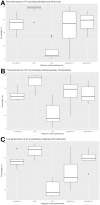Performance of cardiopulmonary exercise testing for the prediction of post-operative complications in non cardiopulmonary surgery: A systematic review
- PMID: 32012165
- PMCID: PMC6996804
- DOI: 10.1371/journal.pone.0226480
Performance of cardiopulmonary exercise testing for the prediction of post-operative complications in non cardiopulmonary surgery: A systematic review
Abstract
Introduction: Cardiopulmonary exercise testing (CPET) is widely used within the United Kingdom for preoperative risk stratification. Despite this, CPET's performance in predicting adverse events has not been systematically evaluated within the framework of classifier performance.
Methods: After prospective registration on PROSPERO (CRD42018095508) we systematically identified studies where CPET was used to aid in the prognostication of mortality, cardiorespiratory complications, and unplanned intensive care unit (ICU) admission in individuals undergoing non-cardiopulmonary surgery. For all included studies we extracted or calculated measures of predictive performance whilst identifying and critiquing predictive models encompassing CPET derived variables.
Results: We identified 36 studies for qualitative review, from 27 of which measures of classifier performance could be calculated. We found studies to be highly heterogeneous in methodology and quality with high potential for bias and confounding. We found seven studies that presented risk prediction models for outcomes of interest. Of these, only four studies outlined a clear process of model development; assessment of discrimination and calibration were performed in only two and only one study undertook internal validation. No scores were externally validated. Systematically identified and calculated measures of test performance for CPET demonstrated mixed performance. Data was most complete for anaerobic threshold (AT) based predictions: calculated sensitivities ranged from 20-100% when used for predicting risk of mortality with high negative predictive values (96-100%). In contrast, positive predictive value (PPV) was poor (2.9-42.1%). PPV appeared to be generally higher for cardiorespiratory complications, with similar sensitivities. Similar patterns were seen for the association of Peak VO2 (sensitivity 85.7-100%, PPV 2.7-5.9%) and VE/VCO2 (Sensitivity 27.8%-100%, PPV 3.4-7.1%) with mortality.
Conclusions: In general CPET's 'rule-out' capability appears better than its ability to 'rule-in' complications. Poor PPV may reflect the frequency of complications in studied populations. Our calculated estimates of classifier performance suggest the need for a balanced interpretation of the pros and cons of CPET guided pre-operative risk stratification.
Conflict of interest statement
The authors have declared that no competing interests exist.
Figures


Similar articles
-
Cardiopulmonary exercise testing for preoperative risk assessment before hepatic resection.Br J Surg. 2012 Aug;99(8):1097-104. doi: 10.1002/bjs.8773. Epub 2012 Jun 14. Br J Surg. 2012. PMID: 22696424
-
Cardiopulmonary exercise testing predicts postoperative outcome in patients undergoing gastric bypass surgery.Br J Anaesth. 2012 Oct;109(4):566-71. doi: 10.1093/bja/aes225. Epub 2012 Jul 18. Br J Anaesth. 2012. PMID: 22810563
-
Cardiopulmonary exercise variables are associated with postoperative morbidity after major colonic surgery: a prospective blinded observational study.Br J Anaesth. 2014 Apr;112(4):665-71. doi: 10.1093/bja/aet408. Epub 2013 Dec 8. Br J Anaesth. 2014. PMID: 24322573
-
Cardiopulmonary exercise testing for the evaluation of perioperative risk in non-cardiopulmonary surgery.Postgrad Med J. 2011 Aug;87(1030):550-7. doi: 10.1136/pgmj.2010.107185. Epub 2011 Jun 21. Postgrad Med J. 2011. PMID: 21693573 Review.
-
Rationale for cardiopulmonary exercise test in the assessment of surgical risk.J Cardiovasc Med (Hagerstown). 2013 Apr;14(4):254-61. doi: 10.2459/JCM.0b013e328354e3c3. J Cardiovasc Med (Hagerstown). 2013. PMID: 22644406 Review.
Cited by
-
Cardiopulmonary exercise testing for cardiovascular risk assessment in patients undergoing gastric and oesophageal cancer surgery: results from a prospective interventional cohort study.Open Heart. 2022 Jul;9(2):e001932. doi: 10.1136/openhrt-2021-001932. Open Heart. 2022. PMID: 35840177 Free PMC article.
-
Utilizing Machine Learning Techniques to Predict the Efficacy of Aerobic Exercise Intervention on Young Hypertensive Patients Based on Cardiopulmonary Exercise Testing.J Healthc Eng. 2021 Apr 21;2021:6633832. doi: 10.1155/2021/6633832. eCollection 2021. J Healthc Eng. 2021. PMID: 33968353 Free PMC article.
-
The association between cardiopulmonary exercise testing and postoperative outcomes in patients with lung cancer undergoing lung resection surgery: A systematic review and meta-analysis.PLoS One. 2023 Dec 7;18(12):e0295430. doi: 10.1371/journal.pone.0295430. eCollection 2023. PLoS One. 2023. PMID: 38060569 Free PMC article.
-
VE/VCO2 slope threshold optimization for preoperative evaluation in lung cancer surgery: identifying true high- and low-risk groups.J Thorac Dis. 2024 Jan 30;16(1):123-132. doi: 10.21037/jtd-23-1292. Epub 2024 Jan 24. J Thorac Dis. 2024. PMID: 38410536 Free PMC article.
-
Objective methods for preoperative assessment of functional capacity.BJA Educ. 2022 Aug;22(8):312-320. doi: 10.1016/j.bjae.2022.03.003. Epub 2022 May 25. BJA Educ. 2022. PMID: 36097575 Free PMC article. Review. No abstract available.
References
-
- NELA Project Team The fourth patient report of the National Emergency Laparotomy Audit. RCoA London, 2018. Available at: https://www.nela.org.uk/reports.
-
- Agnew N Preoperative cardiopulmonary exercise testing Contin Educ Anaesthesia, Crit Care Pain. 2010; 10: 33–37.
Publication types
MeSH terms
Grants and funding
LinkOut - more resources
Full Text Sources
Medical
Miscellaneous

